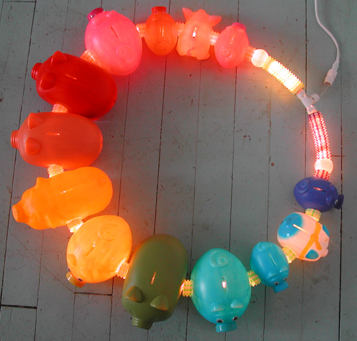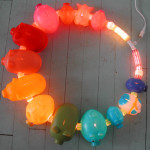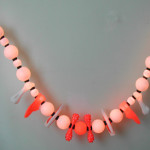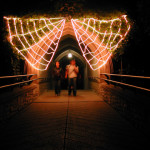By JENNIFER MCMACKON
Toronto artist Lisa Neighbour speaks with Jennifer McMackon about life and death, sculpture and the resistance language of electrical wiring:
JM: Lisa Neighbour, I seem to recall a big shift in your work about ten or maybe twelve years ago. It seemed like you were sailing along and then you said, "Let there be light!". What started you working with light? Was it a matter of slow evolution or an epiphany?
LN: The first time I remember using lights was in 1982. I was having a crisis of sorts, the what’s it all for, why bother, who cares variety, and I spent a lot of time looking out the window. In front of our studio there was a church all lit up with crowns and religious iconography. The decorations were made of plywood and small coloured bulbs. The first light pieces I made were out of plywood and coloured bulbs – I was just pleasing myself, very selfish and goofy. The first time I exhibited work with lights was in 1993, a show called “In the Dark” at Red Head. It was related to divination, trying to see the future, which from this vantage point looks very appropriate, however futile, for that moment in my life.
JM: Is your work sculpture? In terms of nomenclature - how do you like people to think of what you do?
LN: I call it sculpture, I think of it as sculpture, but I’m really not sure what it is. I’m heading more and more toward putting work out there in the world, like fruit in the trees. Solar power has freed up my thinking a lot in the last year. I’ve been able to imagine how the little glow-in-the-dark pomegranate could have a life of it’s own, out in the woods. It’s amazing to cut loose from the wall socket and the extension cords.
JM: Tyler Green recently quoted John Chamberlain in conversation with Michael Auping, "In finding your place in sculpture, you need to find the material that offers you the right resistance. As it turns out, car metal offers me the correct resistance so that I can make a form -- not overform it or underform it". Do you think about resistance in making your work?
LN: The wires do have a resistance language, like paint or marble. I can wrestle a bit with wires, and maybe get blisters from knitting them or the occasional electrical shock. There is a deeper point of connection however – I have to keep them alive, functioning, energized. I acknowledge a system or flow through the work. I think electricity is more important to me in some ways than light. The light is a sign that the electricity is there. I’ve also done pieces where the electricity manifested its presence as sound (clocks, radios) or as water flowing (fountains) or as an invisible electro-magnetic field. Somehow light seems to be the central one because it is fascinating to the human eye, and it has an emotional effect that precedes any conscious reading of the thing.
JM: Is light symbolic in your work?
LN: If light symbolizes anything it would be contingency, vulnerability, magic, the constant presence of non-existence in our existence. In other words while being alive we have a tacit awareness that we are also dead. There is a choice involved. The function of a switch in electrical devices has always fascinated me, because it’s reversible. The lamp dies, comes alive, dies and comes alive over and over again.
JM: You've been through the wringer with a cancer diagnosis and successive treatment in the last year or so. And you've inspired us all with your strength and amazing good cheer throughout - it is awesome and also fearsome but can you talk a little about it?
LN: As I mentioned in response to your earlier question , I am already dead, so now I am officially the un-dead!! I have a Buddhist heart, and death has really lost its meaning except as a bit of spice in the stew. If anything, the experience of discovering how sick I was with surgery, chemotherapy, radiation, drugs - it was like a confirmation of something I already suspected; an easy life is so nice, but struggle is an essential part of being human. It’s very different if you float down the river, or if you decide to swim upstream, nearly drown, go over a waterfall, learn how to breathe under water, and then go with the current like a fish.
JM: Coming out of this crisis and finding a new routine with new perimeters - you teach and you're also going back to school yourself - what is happening with your art practice? What are you working on? Exhibitions coming up? New directions?
LN: Right now I’m a bit freaked out. I have to trick myself into trying new things, telling myself “Oh it will be easy. You’re such a genius. Ha ha no problem” , because part of me is so lazy. I was very worried that after the treatments my brain no longer worked, and that I’d lost the willpower to do anything. This fortunately proved to be only temporary. I’m being a bit macho about it because I still don’t quite believe that I’m OK again. I’ve been really enjoying being a student – I can feel parts of my mind coming back to life. It is giving me inspiration as far as teaching is concerned – knowledge can be like candy, you want it, you crave it. My work is all over the map. Since I started back up last summer I’ve been making small pieces with LEDs and solar panels, using rope lights, fake flame lights, its all gone a bit Goth. Carlo (Neighbours partner, artist, Carlo Cesta) says I’ve finally developed a sense of humour. I think he’s right. I was too earnest, I must have pissed people off with that. I have finally perfected my “Fuck You” attitude. Right now I’m making a piece with 7 bats, biting each other on the ass, and it’s about the energy circulation in the body… it’s a work in progress! I’ve taken up Tai Chi to help bring back circulation after loosing a lot of lymph nodes (is this too much information!?!) and the whole thing reminds me so much of a wiring schematic for a toaster-oven.
JM: What living artist has most influenced your work?
LN: Here’s where I reveal my sappy tendencies. I really like Mike Kelley, he’s been the one I go back to over and over, if I feel discouraged. I’ve recently gotten into Yayoi Kusama, I seem to share part of her brain sometimes. I can’t say one person, but Felix Gonzalez-Torres is right up there too. I just saw a great video by Corinna Schnitt, at MOCCA. It’s very simple, but it just rocked my world – it’s called “once upon a time” did you see it? All kinds of animals are hanging out in a living room, eating the potted plants and interacting with each other. I laughed so much, but it has had quite an effect on me. Did I mention Carlo Cesta? He is very influential to me, he patiently nudges me to keep me awake.
JM: Your answer prompts another couple of questions. What is it about Kelley's work that inspires you? Has it changed over the years? Also, at what moments have you most felt the influence of your mate on your work? How do you manage the influence of your partner in the studio? Have the two of you developed any strategies over the years...?
LN: Mike Kelley has an ironic sense of humour, a sharp intelligence and a non-conformist way of making his work - sometimes it's profound, sometimes it's disgusting, sometimes it has pathos and once in a while it's mean and nasty. There's a slap-stick quality to his work that makes me see the world as hilariously sad and goofy.
Carlo actually has a memory for who did what and when, which I emphatically do not. He helps me find a context for my ideas, which otherwise dribble out at random. We talk about our work at breakfast for heavens sake. He brings huge heavy books along when we go camping, it's a joke between us. We share a studio, (oh this is so not a good idea!) but somehow we work it out. He makes huge prolific crazy things that fill up every nook and cranny. We're both awfully messy. Today we were shoveling out for a studio visit, it requires hours, loud music, throwing things out which we both hate to do. I'm kind of in awe of him still, I feel like he's got a mission in life, while I'm more of a ditherer. Mainly, we respect each other and say the hard things with love and compassion.
JM: Have you ever had really good art envy? Have you ever seen a work of art by another artist you wish you made yourself?
Yeah last Fall, the work at Prefix Gallery, by Finnbogi Petursson. a piece called Sphere. I went back and visited it 3 times. It was a magnificent combination of sound, light, and movement. It made me realize that there’s always something coming at you, a wonder, and awe, that is simultaneously primitive and gorgeous. I wanted to have it right next to me, so that I could visit it everyday for the rest of my life. It hypnotized everyone like chickens. We lay on the floor and couldn’t get up.
JM: What is your favorite work in all of art history?
LN: If I had to pick one, I’d say “Fox Fires by the Iron Tree at Oji”, by Ando Hiroshige (1797-1858). because of it’s odd atmosphere. It was made the year before he died, and his mood was contemplative.
- Lisa Neighbour, Money, rope lights, piggy banks, plastic toys, 2007
- Lisa Neighbour, Dogs’ Collection, rope lights, plastic dog toys, 2007
- Lisa Neighbour , Welcome All Flies, rope lights, at The University of Toronto, 2007
In this print the iron tree is surrounded by foxes made up of flames – they were troublemakers in Japanese folklore. They came out at New Years and gathered at this tree. I have lots more favourites, but they seem like obvious ones, this one is pretty obscure.
Lisa Neighbour ‘s work was most recently exhibited at The Museum of Contemporary Canadian Art and The Tree Museum. Lisa is a member of Hart House Installation Collective and the intrepid Persona Volare. Her work is represented by Katharine Mulherin Contemporary Art Projects.
All images are courtesy of the artist.







